HAM Radio Antenna Connectors- Best, Free & Valuable Knowledge 4 you!
This article is all about the 5 most common HAM Radio Antenna Connectors. Even though there are many different RF Connectors, our focus will be on the most common ones you will encounter.
In the picture at the right from left to right these connectors are: PL-259, Type N Male, BNC Male, TNC Male, and SMA Male.
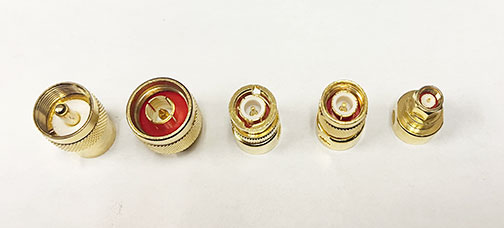
A Little Background to Start
While you may have no problem identifying which standard polarity RF connectors are pin (male) or socket (female), do you find it difficult to identify the gender of reverse polarity connectors? If so you are among a large group. Don’t worry, and remember, you are certainly not alone.
In addition to the gender issue, it’s easy for us all to get confused by the many different types of RF connectors used in HAM Radio, Test Equipment and Electronics Equipment in general.
When you are using HAM Radio Antenna Connectors and trying to connect your devices, you may sometimes wonder which connector type you have and/or which connector type you need.
In this short article, I will explain the difference between center pin (male) and center socket (female) RF Connectors. We will also cover their polarity—standard or reverse (RP). We will include a number of images to help you identify the various types of connectors that are commonly used.
Basic Background
RF (radio frequency) connectors are commonly used on many different products, such as Antennas, radios, surge protectors, enclosures, coaxial cables, and test equipment. These connectors come in a variety of types. The most common connector types are the 5 types shown in the group picture above and in the individual descriptions below.
Gender and Polarity
When using HAM Radio Antenna Connectors and you’re trying to identify pin (male) and socket (female) connectors, you may find it useful to keep in mind the following:
When mating two connectors, it is important to ensure that both connectors have the same polarity. For example, both should be RP-SMA. Typically, RF plugs are pin (male), and the threads are on the inside of the shell.
Typically, RF jacks are socket (female), and the threads are on the outside of the shell.
The shell of a plug (male) typically covers the shell of a jacket (female).
Building off of these concepts, here are some more helpful descriptions:
A standard polarity plug (male) has a center pin that sticks out from the middle, and
the plug’s shell has threads on the inside.
A standard polarity jack (female) has a socket in the middle designed to receive the
pin from the plug (male), and the jack’s shell has threads on the outside.
A reverse polarity plug (male) has a socket in the middle designed to receive the
pin from the jack (female) connector, and the plug’s shell has threads on the
inside.
Remember, reverse polarity jack (female) has a center pin that sticks out from the middle, and the jack’s shell has threads on the outside.
Remember This!:
A standard polarity jack (female) has a socket, whereas a reverse polarity jack (female) has a pin.
A standard polarity plug (male) has a pin, whereas a reverse polarity plug (male) has a socket.
Our goal in this article is to give you the descriptions, information and images to help you understand the differences between the different connector types and the relationships of polarity and gender.
The following descriptions and images will help you identify the 5 types of connectors most commonly used in radio as well as their genders:
UHF Connector PL-259 & SO-239
ΩUHF PL-259 Male & SO-239 Female
- The original “UHF” connector from the 1940 era when 50MHz was UHF
- 50 Ω impedance
- High power 1500W+ at 50MHz
- Useable to 50MHz without too much loss
- Commonly used at VHF and UHF today (higher loss above 50MHz)
- Not constant impedance. Each connector has about 1dB loss
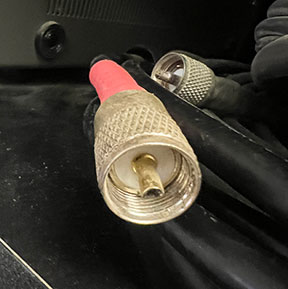
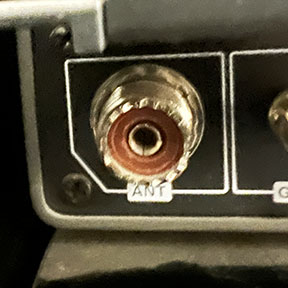
The UHF connector is a name for a threaded RF connector that is probably the most used connector in Amateur and CB Radio. The connector design was invented in the 1930s for use in the radio industry. It is basicly a shielded form of the “banana plug“.
It is a widely used standard connector for HF transmission lines on full-sized radio equipment being able to handle high 1500W power at 500 V peak. Because of the large size of the UHF connectors BNC connectors are preferred and used for smaller, hand-held equipment.
UHF connectors are cheap and easy to install. In all other respects, they are inferior to more modern designs like BNC or N connectors. Each UHF connector has about 1dB loss which means if you have 1500W going through it 35W will be lost in the connector as heat. The heat will build to the point it can melt plastic and solder.
Type N Connector
The N connector (also, type-N connector)
- Threaded, weatherproof
- Medium size RF Connector
- Initially for microwave frequencies
- Modern designs up to 18GHz
- High power capacity 500W +
- Far superior to the UHF PL-259
- Constant impedance = low loss
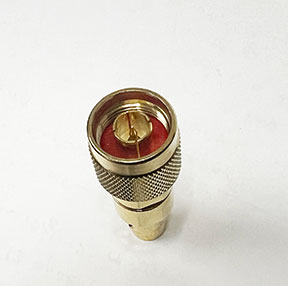
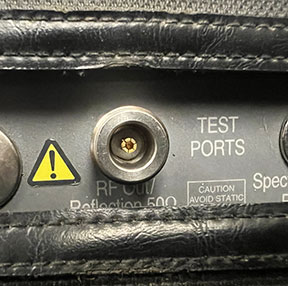
The N connector (also called type-N connector) is a threaded, weatherproof, medium-size RF connector used to join coaxial cables. It was one of the first connectors capable of carrying microwave-frequency signals at 1GHz, and was invented in the 1940s by Paul Neill of Bell Labs, from which the connector is named.
As frequencies increased the old “standby” UHF PL-259 was only good to 50 MHz without too much loss. This created the urgent need by the Military for connectors that could handle higher frequencies better.
It was one of the initial connectors capable of transmitting microwave-frequency signals. The N connector was originally designed for military use to carry signals up to 1 GHz, but modern designs can easily handle frequencies up to 11 GHz, with some enhancements pushing this limit to 18 GHz.
BNC Connector
BNC Connector
- Bayonet Neill-Councelman Connector
- Useable to over 2GHz
- Robust and reliable design
- Can handle over 500W at 100MHz, 100W at 2GHz
- Widely used in RF, Video, & Electronics Test Equipment
- Constant impedance yields low loss. (50 Ω and 75 Ω available)
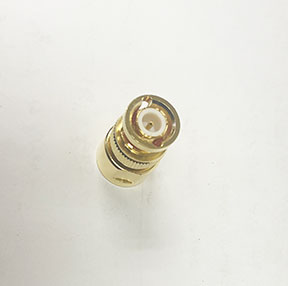
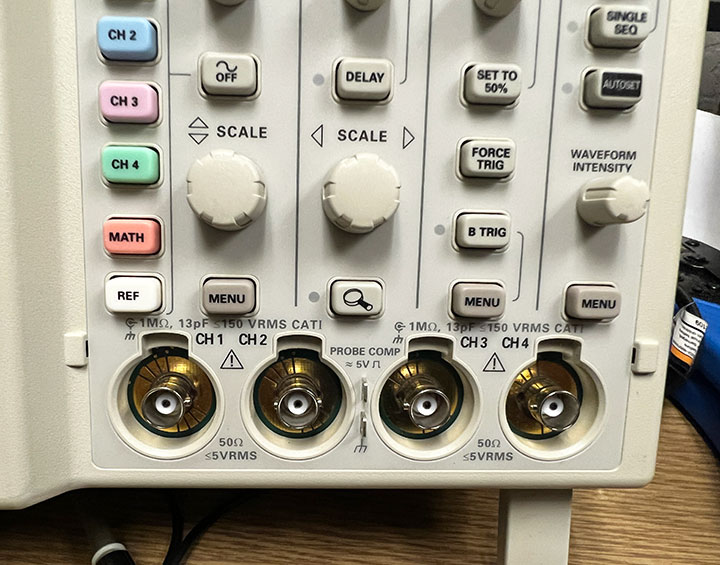
The BNC Connector is one of the most widely used connectors in the Electronics & Radio Industries. As you can see from above the specifications are excellent and the durability is also very robust. Almost every piece of our high end test equipment uses BNC connectors (see the photo above of the Tektronix Oscilloscope).
The BNC was the norm in small and handheld radios up until recent times. Now we see the SMA family of connectors coming into wide usage due to their small format.
You can learn more about BNC Connectors by clicking here.
TNC Connector
TNC Connector
- Threaded Neill-Councelman Connector
- Higher frequency than the BNC (operates at 0-11GHz).
- Handles over 1Kw at 100MHz & 250W at 11GHz
- Constant impedance low loss 50 Ω (75 Ω are available).
- More permanent & durable than the BNC
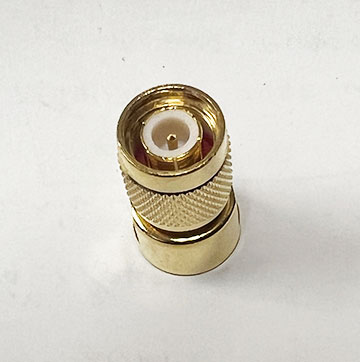
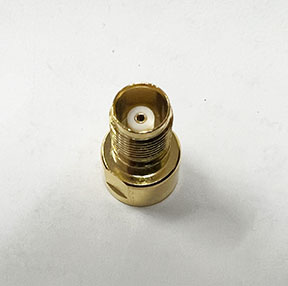
The TNC connector (acronym of “Threaded Neill–Concelman”) is a threaded version of the BNC connector.
The interface specifications for the TNC and many other connector types are referenced in MIL-STD-348. The connector has a 50 Ω impedance (75 Ω also available) and operates best in the 0–11 GHz frequency spectrum. It has better performance than the BNC connector at microwave frequencies.
Invented in the late 1950s and named after Paul Neill of Bell Labs and Carl Concelman of Amphenol. The design allows for the proper torque to be applied for optimum performance. It also gives a more permanent connector installation. The TNC connector has been employed in a wide range of radio, RF and electronic applications.
SMA Connector
SMA Connector
- Acronymn from Sub-Minature version A
- 50 Ω impedance
- Can handle 100W at 10GHz & 1Kw at 100MHz
- Can Operate at Over 18 GHz
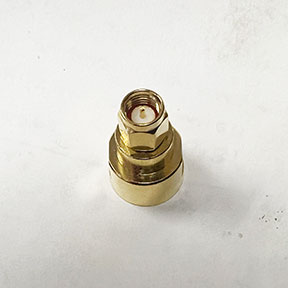
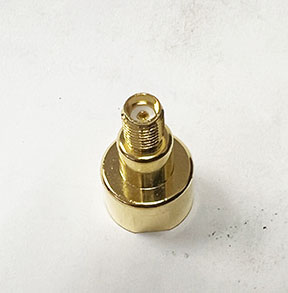
SMA (SubMiniature version A) connectors are small, semi-precision coaxial RF connectors. They were developed in the 1960s as a minimal connector interface for coaxial cable with a screw-on coupling mechanism. This design allows consistent torque to be applied for optimum performance.
The connector has a 50 Ω impedance. The SMA was originally designed for use from DC (0 Hz) to 12 GHz, however this has been extended over time and versions are available to 18 GHz and 26.5 GHz.
The SMA connector is commonly used in microwave systems, hand-held radios, mobile telephone antennas, WiFi antenna systems and, more recently, with a wide range of electronic test equipment. Interestingly it is also used in radio astronomy, particularly at higher frequencies (5 GHz+).
Connector design
The interface dimensions for SMA connectors are found in MIL-STD-348. The SMA connector employs a 1⁄4 inch diameter, 36-thread-per-inch threaded barrel. The male is equipped with a hex nut measuring 5⁄16 inch (0.3125 inch / 7.9 mm) across opposite flats, thus taking the same wrench as a #6 SAE hex nut.
This small RF connector is rated at 500 connect/disconnect cycles to maintain full specs but they last for many more cycles although performance starts to degrade with more usage.
A standard-polarity SMA male connector has a 0.9mm diameter center pin surrounded by barrel with inside threads, and the standard SMA female connector has a center sleeve surrounded by a barrel with outside threads. The center pin is the same diameter as the center of RG402 Coax so that connections can be made with no discontinuity, forming the pin from the coax itself.
Why do We Have Reverse Polarity Connectors?
So, how do we answer the question about how reverse polarity connector types became so common.
This is a result of the FCC (Federal Communications Commission) introducing regulations for low-power non-licensed transmitters, which are commonly known as Part 15 transmitters.
Some twenty years ago, the FCC in the U.S. introduced the practice of using “unique connectors” (that is, connectors that are not available as a standard part at electronics stores). The theory behind this practice was that it would be difficult for someone to purchase and attach a non-certified antenna to a device.
In the past two decades, however, the practice of using “unique connectors” has become commonplace, which has led to the wide spread use of reverse polarity connector types.
Let’s take a closer look and sort these connectors out. Gender and Polarity are not that difficult to distinguish. When you’re trying to identify pin (male) and socket (female) connectors, you may find it usefull to keep in mind the following facts:
When mating two connectors, it is important to ensure that both connectors have the same polarity. For example, in the case of SMA connectors both should be Standard or both should be Reverse Polarity ( RP-SMA).
As a general rule, RF plugs are pin (male), and the threads are on the inside of the shell. Generally, RF jacks are socket (female), and the threads are on the outside of the shell. The outer shell of a plug (male) typically covers the shell of a jacket (female).
Expanding from these concepts, here are some more helpful descriptions:
A standard polarity plug (male) has a center pin that sticks out from the middle, and the plug’s shell has threads on the inside.
A standard polarity jack (female) has a socket in the middle designed to receive the pin from the plug (male), and the jack’s shell has threads on the outside.
A reverse polarity plug (male) has a socket in the middle designed to receive the pin from the jack (female) connector, and the plug’s shell has threads on the inside.
Remember, reverse polarity jack (female) has a center pin that sticks out from the middle, and the jack’s shell has threads on the outside. Reverse Polarity jacks can be on a variety of radio & test equipment.
Remember:
Like most other connectors, the gender assignment corresponds to the innermost electrical component (the center pin or socket). As an example, there are also reverse-polarity (“RP”) SMA connectors in which the pin and sleeve are swapped so that the “male” RP-SMA has a center socket/sleeve surrounded by an inside-threaded barrel, and the “female” RP-SMA has a center pin and an outside-threaded barrel. See below for a fuller description.[1]
A standard polarity jack (female) has a socket, whereas a reverse polarity jack (female) has a pin.
A standard polarity plug (male) has a pin, whereas a reverse polarity plug (male) has a socket.
The following descriptions and images show the two most common reverse polarity (RP) connectors that we use:


Remember, a reverse polarity jack (female) has a center pin that sticks out from the middle, and the jack’s shell has threads on the outside. Here in the left hand picture we have shown an RP-SMA jack as used in the Baofeng and many other imported radios, as well as other radio and test equipment. The right picture shows a regular or “straight” style SMA connector as is used in Yaesu and many other radios and test equipment.
Remember (once again):
A standard polarity jack (female) has a socket, whereas a reverse polarity jack (female) has a pin.
A standard polarity plug (male) has a pin, whereas a reverse polarity plug (male) has a socket.
Reverse Polarity SMA (RP-SMA)
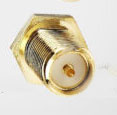
The Female RP-SMA has a male center pin with threads on the outside of the connector (Pin with threads on outside).
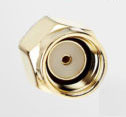
The Male RP-SMA has a female center socket with female threads on the inside of the connector (Socket with threads inside).
Reverse Polarity TNC (RP-TNC)
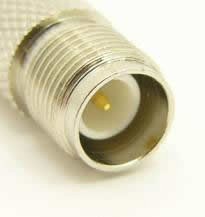
The Female RP-TNC has a male center pin with threads on the outside of the connector (Pin with threads outside).
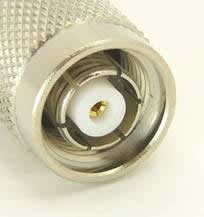
The Male PR-TNC has a female center socket with female threads on the inside of the connector (Socket with threads inside).
This concludes our discussion of the 5 most popular RF connector types (including the two reverse polarity types). The goal was to decrease confusion and to increase understanding regarding connectors.
We hope that the information, descriptions and images in this article have helped you understand the differences between the different connector types and the relationships of polarity and gender.
